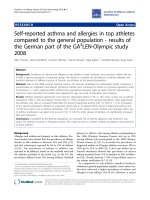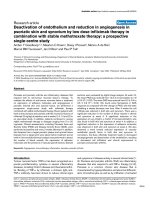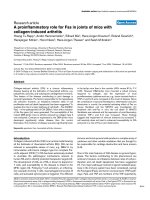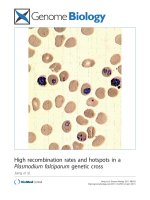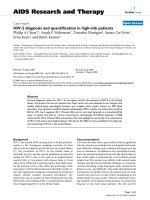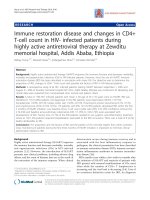Báo cáo y học: "yrosine kinase – Role and significance in Cancer"
Bạn đang xem bản rút gọn của tài liệu. Xem và tải ngay bản đầy đủ của tài liệu tại đây (574.76 KB, 15 trang )
Int. J. Med. Sci. 2004 1(2): 101-115
101
International Journal of Medical Sciences
ISSN 1449-1907 www.medsci.org 2004 1(2):101-115
©2004 Ivyspring International Publisher. All rights reserved
Tyrosine kinase – Role and significance in Cancer
Review
Received: 2004.3.30
Accepted: 2004.5.15
Published:2004.6.01
Manash K. Paul and Anup K. Mukhopadhyay
Department of Biotechnology, National Institute of Pharmaceutical Education and Research,
Sector-67, S.A.S Nagar, Mohali, Punjab, India-160062
A
A
b
b
s
s
t
t
r
r
a
a
c
c
t
t
Tyrosine kinases are important mediators of the signaling cascade,
determining key roles in diverse biological processes like growth,
differentiation, metabolism and apoptosis in response to external and
internal stimuli. Recent advances have implicated the role of tyrosine kinases
in the pathophysiology of cancer. Though their activity is tightly regulated in
normal cells, they may acquire transforming functions due to mutation(s),
overexpression and autocrine paracrine stimulation, leading to malignancy.
Constitutive oncogenic activation in cancer cells can be blocked by selective
tyrosine kinase inhibitors and thus considered as a promising approach for
innovative genome based therapeutics. The modes of oncogenic activation
and the different approaches for tyrosine kinase inhibition, like small
molecule inhibitors, monoclonal antibodies, heat shock proteins,
immunoconjugates, antisense and peptide drugs are reviewed in light of the
important molecules. As angiogenesis is a major event in cancer growth and
proliferation, tyrosine kinase inhibitors as a target for anti-angiogenesis can
be aptly applied as a new mode of cancer therapy. The review concludes with
a discussion on the application of modern techniques and knowledge of the
kinome as means to gear up the tyrosine kinase drug discovery process.
K
K
e
e
y
y
w
w
o
o
r
r
d
d
s
s
Tyrosine kinase; Cancer; Oncogenic activation; Inhibitor; Drug discovery
A
A
u
u
t
t
h
h
o
o
r
r
b
b
i
i
o
o
g
g
r
r
a
a
p
p
h
h
y
y
Anup K. Mukhopadhyay is an Associate Professor of the Department of Biotechnology,
National Institute of Pharmaceutical Education and Research, Punjab, India-160062. His
research interest is in the area of mitochondrial bioenergetics of cancer cell of haemato-
oncologic diseases. His research interest also includes kinetics of electron transfer enzyme
and reactive oxygen species.
Manash K. Paul is a PhD student of the Department of Biotechnology, National Institute of
Pharmaceutical Education and Research, Punjab, India-160062. his current research includes
target enzymes in cancer therapeutics and mitochondrial bioenergetics in cancer leukocyte.
C
C
o
o
r
r
r
r
e
e
s
s
p
p
o
o
n
n
d
d
i
i
n
n
g
g
a
a
d
d
d
d
r
r
e
e
s
s
s
s
Dr. Anup K. Mukhopadhyay, NIPER Communication No 283. e-mail:
or Fax: 91172214692 Tel:
911722214682
Int. J. Med. Sci. 2004 1(2): 101-115
102
1. Introduction
Multicellular organisms live in a complex milieu where signaling pathways contribute to critical
links, for their existence. Tyrosine kinases are important mediators of this signal transduction process,
leading to cell proliferation, differentiation, migration, metabolism and programmed cell death.
Tyrosine kinases are a family of enzymes, which catalyzes phosphorylation of select tyrosine residues
in target proteins, using ATP. This covalent post-translational modification is a pivotal component of
normal cellular communication and maintenance of homeostasis [1,2]. Tyrosine kinases are implicated
in several steps of neoplastic development and progression. Tyrosine kinase signaling pathways
normally prevent deregulated proliferation or contribute to sensitivity towards apoptotic stimuli. These
signaling pathways are often genetically or epigenetically altered in cancer cells to impart a selection
advantage to the cancer cells. Thus, it is no wonder that aberrant enhanced signaling emanating from
tyrosine kinase endows these enzymes a dominating oncoprotein status, resulting in the malfunctioning
of signaling network [3].
The discovery that SRC oncogene having a transforming non receptor tyrosine kinase activity [4],
and the finding of EGFR, the first receptor tyrosine kinase paved the way to the understanding of the
role and significance of tyrosine kinase in cancer [5]. With the deciphering of the Human Genome
Project more than 90 tyrosine kinases have been found out. The more science entangles the intricacies
of cellular signaling the more we find the involvement of tyrosine kinase in cellular signaling circuits
that are implicated in cancer development. Tyrosine kinases represent a major portion of all oncoprotein
that play a transforming role in a plethora of cancers. Hence the identification and development of
therapeutic agents for disease states that are linked to abnormal activation of tyrosine kinases due to
enhanced expression, mutation or autocrine stimulation leading to abnormal downstream oncogenic
signaling have taken a centre stage as a potent target for cancer therapy [6,7].
2. Biochemical mechanism of action of tyrosine kinase
Tyrosine kinases are enzymes that selectively phosphorylates tyrosine residue in different
substrates. Receptor tyrosine kinases are activated by ligand binding to their extracellular domain.
Ligands are extracellular signal molecules (e.g. EGF, PDGF etc) that induce receptor dimerization
(except Insulin receptor). Different ligands employ different strategies by which they achieve the stable
dimeric conformation. One ligand may bind with two receptor molecules to form 1:2 ligand: receptor
complex e.g. growth hormone and growth hormone receptor, while in other cases two ligands binds
simultaneously to two receptors 2:2 ligand receptor complex and provides the simplest mechanism of
receptor dimerization e.g. VEGF and VEGFR. The receptor dimerization is also stabilized by receptor–
receptor interactions. Some ligand receptor is not sufficient for some complex and is stabilized by
accessory molecules e.g. FGFs are unable to activate FGFR complex and is stabilized by heparin sulfate
proteoglycans (HSPG). Ligand binding to the extracellular domain stabilizes the formation of active
dimmers and consequently protein tyrosine kinase activation.
Structural studies of the catalytic core of several RTKs, supported by biochemical and kinetic
studies of receptor phosphorylation have provided proof that receptor oligomerization increases the
local concentration of the RTKs, leading to efficient transphosphorylation of tyrosine residues in the
activation loop of the catalytic domain. Upon tyrosine phosphorylation the activation loop adopts an
open conformation that gives access to ATP and substrates and makes ATP transfer from Mg-ATP to
tyrosine residue on the receptor itself and on cellular proteins involved in signal transduction.
The ATP binding intracellular catalytic domain that catalyzes receptor autophosphorylation
displays the highest level of conservation between the RTKs. The ATP binding site serves as a docking
site for specific binding of cytoplasmic signaling proteins containing Src homology-2 (SH2) and protein
tyrosine binding (PTB) domains. These proteins in turn recruit additional effector molecules having
SH2, SH3, PTB and Pleckstrin homology (PH) domain. This results in the assembly of signaling
complexes to the activated receptor and the membrane and subsequent activation of a cascade of
intracellular biochemical signals, which leads to the activation or repression of various subsets of genes
and thus defines the biological response to signals. During these processes, receptors migrate within the
plasma membrane and are internalized through clathrin-coated invagination, which eventually seal off
and forms an endocytic vesicle. The endocytic vesicles fuse with the lysosomes and in the process the
Int. J. Med. Sci. 2004 1(2): 101-115
103
receptor and ligand may be degraded by the lysosomal enzymes. The receptors are also recycled in
some cases. During the whole process of receptor internalization the ligand receptor complex is
dissociated and this results in the termination of the signaling reaction.
Figure 1. Schematic representation of the mode of action of tyrosine kinase. PK represents protein
kinase and PP stands for protein phosphatase.
3.
Classification
Tyrosine kinases are primarily classified as receptor tyrosine kinase (RTK) e.g. EGFR, PDGFR,
FGFR and the IR and non-receptor tyrosine kinase (NRTK) e.g. SRC, ABL, FAK and Janus kinase. The
receptor tyrosine kinases are not only cell surface transmembrane receptors, but are also enzymes
having kinase activity. The structural organization of the receptor tyrosine kinase exhibits a
multidomain extracellular ligand for conveying ligand specificity, a single pass transmembrane
hydrophobic helix and a cytoplasmic portion containing a tyrosine kinase domain. The kinase domain
has regulatory sequence both on the N and C terminal end [2,8].
NRTK are cytoplasmic proteins, exhibiting considerable structural variability. The NRTK have a
kinase domain and often possess several additional signaling or protein-protein interacting domains
such as SH2, SH3 and the PH domain [9]. The tyrosine kinase domain spans approximately 300
residues and consists of an N terminal lobe comprising of a 5 stranded β sheet and one α helix, while
the C terminal domain is a large cytoplasmic domain that is mainly α helical. ATP binds in the cleft in
between the two lobes and the tyrosine containing sequence of the protein substrate interacts with the
residues of the C terminal lobe. RTK are activated by ligand binding to the extracellular domain
followed by dimerization of receptors, facilitating trans-phosphorylation in the cytoplasmic domain
whereas the activation mechanism of NRTK is more complex, involving heterologous protein-protein
interaction to enable transphosphorylation [10].
Figure 2. Mechanism of action of tyrosine kinase. 1. Receptor expression at membrane claveola 2.
Ligand binding 3. Hetero/homodimerization leading to tyrosine kinase activation and tyrosine
transphosphorylation 4. Signal transduction 5. Receptor internalization 6. Receptor degradation or re-
expression.
ADP
P
ADP
P
Y
Substrate
Y
Substrate
PK
PP
P
Int. J. Med. Sci. 2004 1(2): 101-115
104
4. Oncogenic activation of tyrosine kinase
Normally the level of cellular tyrosine kinase phosphorylation is tightly controlled by the
antagonizing effect of tyrosine kinase and tyrosine phosphatases. There are several mechanisms by
which tyrosine kinase might acquire transforming functions, but the ultimate result is the constitutive
activation of normally controlled pathways leading to the activation of other signaling proteins and
secondary messengers which serves to hamper the regulatory functions in cellular responses like cell
division, growth and cell death [11]. Constitutive activation of tyrosine kinase may occur by several
mechanisms.
4.1. Activation by mutation
An important mechanism leading to tyrosine kinase deregulation is mutation. Mutations within the
extracellular domain e.g. EGFRv III mutant lacks amino acid 6-273 which gives rise to receptor
tyrosine kinase constitutive activity, that leads to cell proliferation in the absence of ligand in
glioblastomas, ovarian tumors and non small cell lung carcinoma [12]. Point mutations either in the
extracellular domain of the FGFR 3 results in an unpaired cysteine residue allowing abnormal receptor
dimerization through intermolecular disulfide bonding, or in the activation loop of kinase domain were
identified in multiple myeloma. Somatic mutations in the EGFR 2 and 3 have been associated with
human bladder and cervical carcinomas. Breakpoints of abnormal chromosomal translocation are also
an important source of mutation [13].
4.1.1. BCR-ABL and human leukemia
CML is a chronic myelodysplastic hematopoietic stem cell disorder syndrome (95% of the CML)
resulting from a reciprocal translocation between chromosome-9 and chromosome-22, the Philadelphia
chromosome. Break point cluster region (BCR) sequences of chromosome-22 on translocation
juxtaposes with the c-ABL tyrosine kinase of chromosome-9. The fusion gene produces a 210 KDa
mutant protein in which the first exon of c-ABL has been replaced by BCR sequences, encoding either
927 or 902 amino acid. Another BCR-ABL fusion protein of 185 KDa containing BCR sequences from
exon 1fused to exon 2-11 of c-ABL, is found in 10% of adult ALL patients. The BCR-ABL chimeric
Transcription
Clathrin pit
Receptor
expression
Ligand
binding
Hetero/Homo
dimerization
TK activation by
transphosphorylation
Receptor
internalization
Degradation
or expression
Down
stream
signaling
ligand
P
Receptor
internalization
P
P
P
Int. J. Med. Sci. 2004 1(2): 101-115
105
gene product has a tyrosine kinase activity several fold higher than it’s normal counterpart and
correlates with the disease phenotype [14,15,16,17,18].
4.1.2. TEL-ABL and human leukemia
TEL-ABL tyrosine kinase like ABL-BCR is constitutively phosphorylated due to reciprocal
translocation t(9,12) in case of ALL and with a complex karyotype t(9,12,14) in patients with CML.
TEL which is a putative transcription factor is fused in-frame with exon-2 of the ABL proto-oncogene,
producing a fusion protein product with elevated tyrosine kinase activity [14,19]. Other important
translocations include t(5,12) in CMML producing TEL-PDGF receptor. The helix-loop-helix motif of
TEL is believed to induce homodimerization and kinase activation of the TEL-ABL and TEL-PDGFRβ
fusion proteins. NPM-ALK fusion products t(2,5) is constitutively activated in Anaplastic large cell
lymphoma [20,21].
4.2. Autocrine-Paracrine loops
Autocrine-paracrine stimulation serves as an important mechanism for the constitutive activation
of tyrosine kinase specially receptor tyrosine kinases. This activation loop is stimulated when a receptor
tyrosine kinase is abnormally expressed or overexpressed in presence of it’s associated ligand or when
there is an overexpression of the ligand in presence of it’s cognate receptor. A role of autocrine-
paracrine stimulation has been immanent in a variety of human cancers. Burning examples are being
provided by EGFR, PDGFR and IGF receptors and their associated ligands [22].
4.2.1. EGFR in autocrine paracrine loops
Strong associations have been studied among the expression of EGFR and it’s primary ligand EGF
and TGFα in many human cancers including non small cell lung cancer [22], bladder cancer, breast
cancer and glioblastoma multiforme. Increased expression of EGFR is reported in 40-80% of non small
cell lung cancer and is also overexpressed in 50% of primary lung cancer [15]. TGFα another ligand of
EGFR is also involved in autocrine paracrine growth loops in 20-40% of lung cancer [23]. EGFR
overexpression of wild type or mutated forms is documented in 40% of cases of glioblastoma
multiforme [24] and 40%-50 % of bladder cancer patient [25].
4.2.2. PDGFR in Autocrine paracrine Loop
Concurrent expression of PDGFR and it’s cognate ligand PDGF-A and PDGF-B has been
observed in most astrocytic brain tumors and gliomas [26].
4.2.3. Insulin like growth factor receptors in Autocrine growth loop
Coexpression of IGFR and its ligand IGF I and IGF II is reported in the pathogenesis of breast
cancer, prostrate cancer and small cell lung cancer [27]. Elevated IGF-I R autophosphorylation and
kinase activity has been reported in breast cancer [28]. Elevated prostrate cancer risk is also correlated
with elevated plasma IGF-I levels [29]. Hence a strong association of autocrine paracrine loops has
been implicated in the pathogenesis of several cancers.
Int. J. Med. Sci. 2004 1(2): 101-115
106
Figure 3. Schematic view of different mechanisms leading to the constitutive activation of tyrosine
kinase.
5. Tyrosine kinases as targets for anticancer agents
The role of tyrosine kinases in cancer molecular pathogenesis is immense and recently kinases
have come in vogue as potential anticancer drug targets, as a result a couple of anticancer drugs are in
the market. The complexity and the number of tyrosine kinases have greatly increased with the
sequencing effort of the Human Genome Project, thus providing more opportunities for drug discovery.
Recent understanding of the molecular pathophysiology of cancer have highlighted that many tyrosine
kinases are found upstream or downstream of epidemiologically relevant oncogenes or tumor
suppressor, in particular the receptor tyrosine kinases [30].
5.1. Site of targeting
Cancer research got a boom with the declaration by the US president Richard Nixon in The
National Cancer Act (1971). By the late 1980 there were evidence of low molecular weight tyrosine
kinase inhibitors. Inhibiting the activity of tyrosine kinases by low molecular weight compounds
capable of interfering with either ligand binding (in the case of receptor tyrosine kinases) [31] or with
protein substrate (in case of non receptor tyrosine kinase) has proved to be difficult [32]. Although the
bisubstrate inhibitor approach offered promise, but with very little practical progress. Approaches to
generate non-competitive or allosteric inhibitors have also failed. The ATP competitive inhibitors
appear to be the target of choice [33].
5.2. The ATP binding site
ATP binds within a deep cleft formed between the two lobes of the tyrosine kinase domain.
Though the ATP binding site is highly conserved the architecture in the regions proximal to the ATP
binding site does afford some key diversity for designing new drug and has potential application in drug
discovery.
The ATP binding sites have the following features-
Ligand
Overexpression of RTK’s Mutation leading
to truncation or other
anomalies
Autocrine loops
Proliferation
Gene transcription
Ligand
Overexpression of RTK’s Mutation leading
to truncation or other
anomalies
Autocrine loops
Ligand
Overexpression of RTK’s Mutation leading
to truncation or other
anomalies
Autocrine loops
Ligand
Overexpression of RTK’s Mutation leading
to truncation or other
anomalies
Autocrine loops
Proliferation
Gene transcription
P
P
P P
P P P P


